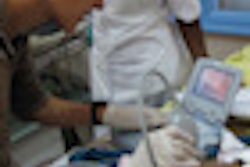3D transvaginal ultrasound performs better and is more cost-effective than hysterosalpingography (HSG) in women with uterine abnormalities, according to a study from Eastern Virginia Medical School.
From the prospective study involving 103 women, researchers determined that 3D transvaginal ultrasound visualized and evaluated the uterine cavity with similar or better accuracy than standard HSG in the office setting. It also yielded lower cost and morbidity.
"These results show 3D ultrasound as a very promising tool which may eliminate the need for diagnostic surgery in the diagnosis of uterine anomalies," said Dr. Silvina Bocca, PhD. She presented the findings at the American Institute of Ultrasound in Medicine (AIUM) annual meeting in April.
Uterine abnormalities are associated with an increased risk of sterility, miscarriage, and obstetrical complications. While some of these abnormalities can often be detected by 2D transvaginal ultrasound, final diagnosis is traditionally obtained by HSG, MRI, or a combination of hysteroscopy and laparoscopy, Bocca said.
The Eastern Virginia team sought to prospectively compare the costs, accuracy, risk, and benefits of 3D transvaginal ultrasound with HSG in women with uterine abnormalities. The group enrolled 101 women (age, 26-44) with evidence of uterine pathology who were attending an infertility clinic.
All participants had a routine HSG as part of their infertility evaluation as well as a 3D transvaginal ultrasound exam as part of the study. The ultrasound exam was performed by one of the investigators on a Voluson Expert scanner (GE Healthcare) using the Z technique for the multiplanar display of the midcoronal plane of the uterus. The scanning investigator was blinded to the HSG findings.
If the patients had received a hysteroscopy with or without laparoscopy, surgical findings were used as the gold standard for their diagnosis. A total of 119 uterine abnormalities were identified; 30 were congenital and 89 were acquired. There were also six normal uteri.
The 30 congenital uterine abnormalities were classified as arcuate (three), unicornuate (one), bicornuate (four), didelphys (two), and septate uteri (20). The 89 acquired abnormalities were classified as polyps (38), fibroids (30), synechiae (17), and adenomyosis (four).
3D detection rates for uterine abnormalities
|
In congenital abnormalities, 3D transvaginal ultrasound detected 100% of fibroids, 100% of synechiae, and 50% of adenomyosis, compared with HSG detection rates of 83%, 80%, and 62%, respectively.
No adverse effects were reported after 3D ultrasound, while six minor/moderate adverse events were reported after HSG.
Cost analysis
Using the Medicare rates from the state of Virginia (not including radiologist or hospital fees), 3D ultrasound has a cost of $138.49 per patient, contrast-enhanced MRI has a cost of $1,539, and HSG has a cost of $408.87. Hysteroscopy has a cost range of $228.24 to $541.96.
3D ultrasound was 100% accurate in the six normal uteri, generating a total cost of $834 ($139 x 6) for all normal patients. No further evaluation or treatment was necessary.
HSG, however, failed to correctly classify these patients, costing a total of $2,454 for all six individuals, Bocca said. In addition, these patients required further evaluation, which would have cost $9,234 ($1,539 x 6) if an MRI was ordered and $1,374 if hysteroscopy ($229 x 6) was needed. The aggregate cost would range from $3,828 to $11,779 for the entire patient group, compared with $834 from the use of 3D ultrasound.
3D ultrasound also correctly diagnosed all 20 septate uteri. This generated a cost of $2,780 ($139 x 20) for diagnosis and $10,840 for hysteroscopic septoplasty ($542 x 20) for evaluation. The aggregate cost for this patient group was $13,620.
"Fifteen of these 20 patients conceived spontaneously," she said.
HSG only correctly diagnosed seven of the 20 patients at an aggregate cost of $6,657, including $2,983 ($409 x 7) for the HSG and $3,794 for septoplasty ($542 x 7). The 13 uncertain diagnoses required further testing, adding an aggregate cost of approximately $19,000 for MRI and $10,000 when hysteroscopy and laparoscopy were ordered.




















